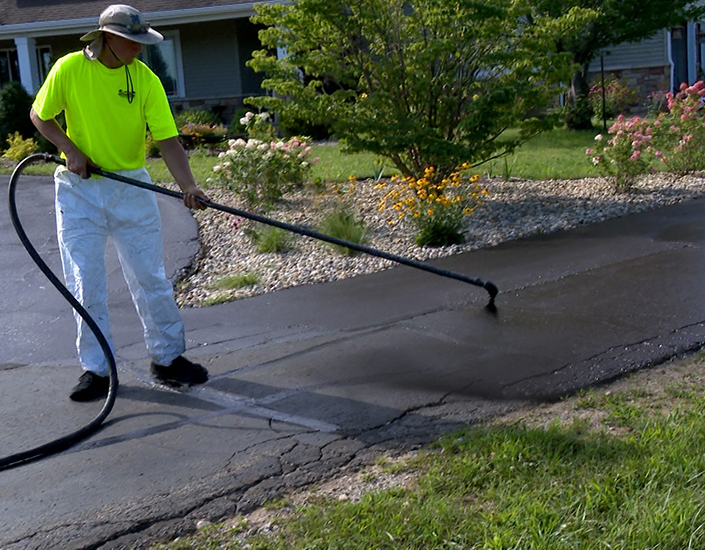Hot Mix Asphalt: A Lasting Remedy for Sidewalk
Warm Mix Asphalt (HMA) has become a leading lasting choice for sidewalk options, providing a myriad of innovative modern technologies and ecological benefits. Its ability to reuse products and decrease power intake presents a compelling situation for its adoption in road construction tasks. The long-term performance and longevity of HMA make it a favored choice for infrastructure development. As the demand for eco-friendly building practices expands, exploring the nuances of HMA's sustainability can supply useful insights right into the future of pavement remedies.
Ecological Advantages of Hot Mix Asphalt

Moreover, Hot Mix Asphalt aids to minimize urban heat island results. Its dark shade absorbs sunshine, reducing the amount of warmth reflected back into the atmosphere contrasted to lighter-colored pavements. This can reduce ambient temperatures in metropolitan areas, decreasing the demand for cooling and eventually lowering power intake.
On top of that, Warm Mix Asphalt adds to enhanced stormwater administration. Its porous nature allows water to penetrate the pavement and recharge groundwater products, decreasing runoff and the risk of flooding. These ecological benefits make Hot Mix Asphalt a lasting option for paving freeways and roads.
Energy Effectiveness in HMA Manufacturing
Is energy efficiency a crucial factor in the production of Warm Mix Asphalt (HMA)? Energy plays a significant duty in the production of HMA, affecting both expense and environmental sustainability. One essential element of power effectiveness in HMA production is the use of warm mix asphalt (WMA) innovations.
Moreover, advancements in plant innovations have actually led to even more energy-efficient HMA production processes. Modern plants are designed with functions like recycled asphalt pavement (RAP) handling abilities, effective heater systems, and improved insulation, all adding to energy financial savings. By enhancing energy usage in HMA production, the industry can minimize its carbon footprint while preserving top quality pavement products. Power performance is, consequently, an important factor to consider in guaranteeing the sustainability of Hot Mix Asphalt manufacturing.
Recyclability of Hot Mix Asphalt
The recyclability of Warm Mix Asphalt (HMA) is a crucial facet of its sustainability and long-term environmental influence. HMA is among one of the most recycled products in the United States, with over 100 million bunches of reclaimed asphalt sidewalk (RAP) being reused annually in new sidewalk building and construction. Reusing HMA provides a number of environmental benefits, such as lowering the requirement for virgin products, reducing energy usage throughout production, and lowering the quantity of waste sent out to garbage dumps.
The procedure of recycling HMA entails milling the existing sidewalk, squashing it right into smaller sized items, and blending it with brand-new accumulation and asphalt binder to develop a recycled mix. This recycled mix can usually do as well as or perhaps much better than traditional HMA, while requiring less resources and creating lower greenhouse gas discharges. By integrating RAP into brand-new sidewalk tasks, roadway firms can preserve all-natural resources, reduce costs, and decrease the environmental impact of road building and maintenance activities. In general, the recyclability of HMA plays a considerable duty in promoting lasting techniques within the pavement industry.

Long-Term Efficiency of HMA
Asphalt sidewalks show resilience and durability over an extensive period, reflecting the lasting efficiency of Hot Mix Asphalt (HMA) Additionally, improvements in HMA modern technology, such as the use of polymer-modified binders and cozy mix asphalt, have actually better improved the toughness and long life of HMA pavements. By prioritizing top quality building and construction and upkeep practices, HMA continues to confirm itself as a cost-effective and lasting remedy for durable useful source sidewalk facilities.

HMA: Toughness and Sustainability
Showing both toughness and sustainability, Hot Mix Asphalt (HMA) has actually become a foundation in the building of lasting sidewalk infrastructures - hot mix asphalt. HMA's toughness originates from its ability to stand up to hefty tons, extreme weather, and high traffic volumes, making it a dependable option for roadways, freeways, and flight terminal runways. The structure of HMA, which generally includes aggregates, binder, and filler, plays a critical function in improving its durability and resistance to deterioration
Additionally, HMA's sustainability depends on its recyclability and energy-efficient manufacturing process. The capability to reuse reclaimed check this asphalt sidewalk (RAP) in brand-new HMA blends lowers the demand for virgin materials and reduces the environmental effect of pavement construction and upkeep. Additionally, the energy effectiveness of producing HMA lies in its reduced mixing temperatures compared to various other pavement materials, bring about lowered power intake and greenhouse gas emissions.
Conclusion
Finally, hot mix asphalt (HMA) supplies a lasting remedy for pavement with its eco pleasant features. HMA's recyclability, energy effectiveness in production, and lasting toughness make it a green option for roadway building and construction. By preserving natural deposits, reducing waste, and reducing greenhouse gas emissions, HMA plays a crucial duty in promoting sustainability in infrastructure development. Its ability to mitigate metropolitan heat island results further underscores its importance in developing environmentally conscious and resistant sidewalk systems.
HMA is one of the most recycled products in the United States, with over hop over to here 100 million heaps of recovered asphalt sidewalk (RAP) being recycled every year in new sidewalk building.The procedure of reusing HMA involves milling the existing pavement, crushing it right into smaller pieces, and blending it with new aggregate and asphalt binder to produce a recycled mix.Asphalt pavements demonstrate toughness and resilience over a prolonged duration, reflecting the long-lasting efficiency of Hot Mix Asphalt (HMA) Additionally, developments in HMA technology, such as the use of polymer-modified binders and cozy mix asphalt, have actually additionally enhanced the durability and longevity of HMA pavements. The ability to recycle recovered asphalt pavement (RAP) in brand-new HMA mixes lowers the demand for virgin materials and minimizes the environmental influence of sidewalk building and maintenance.